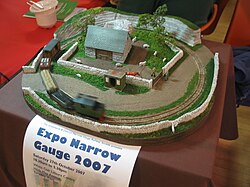
Railway modelling has long used a variety of scales and gauges to represent its models of real subjects. In most cases, gauge and scale are chosen together, so as to represent Stephenson standard gauge. By choosing a smaller gauge than this for a particular scale, the model represents a narrow-gauge example. [1] [2]
Contents
Such gauge and scale combinations are of course used for the deliberate modelling of particular narrow-gauge subjects, where the choice of subject is behind the choice of combination. Narrow-gauge modelling has also become especially popular from the purely modelling aspects: it combines a conveniently visible large scale that is easier to work on, with a narrow model gauge that allows tighter radius curves and so fits layouts into smaller spaces. This has been a particular reason in Europe where, houses being generally smaller than in the US, there is rarely space for 0 gauge and even 00 gauge is restricted in the size of curves.
At times, particularly in the early days before the inertia of popular scales developed, modellers would choose seemingly random scales in order to model a particular prototype and its original gauge whilst using a readily available gauge. [3] As the range of commercial products increases, both for gauges and scales, it is easier to find a combination that is already supported and so there is less need to scratch-build everything. [1]
